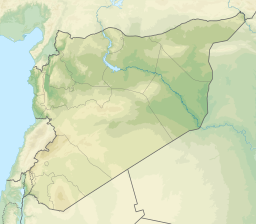| Sabkhat al-Jabbul | |
|---|---|
| سبخة الجبول (Arabic) | |
 Sentinel-2 image (2022) | |
| Location | Aleppo Governorate |
| Coordinates | 36°04′N 037°30′E / 36.067°N 37.500°E |
| Type | Salt lake |
| Basin countries | Syria |
| Surface area | 100 km2 (39 sq mi) |
| Official name | Sabkhat al-Jabbul Nature Reserve |
| Designated | 5 March 1998 |
| Reference no. | 935[1] |
Sabkhat al-Jabbūl or Mamlahat al-Jabbūl[2] or Lake Jabbūl (Arabic: سبخة الجبول) is a large, traditionally seasonal, saline lake and concurrent salt flats (sabkha) 30 km southeast of Aleppo, Syria, in the Bāb District of Aleppo Governorate. It is the largest natural lake in Syria and the second largest lake after the artificial Lake Assad. In 2009 the lake covered about 100 km2 (39 sq mi) and was relatively stable.[3] The salt flats are extensive. The area includes the Sabkhat al-Jabbul Nature Reserve, a protected waterfowl site.[4]

Today the Sabkhat al-Jabbul exists within a closed basin, but during the Pleistocene the basin filled, overflowed and formed a tributary of the Euphrates. The lake traditionally flooded in the spring, shrinking back during the summer and autumn. However, starting in 1988, irrigation projects on adjacent lands started discharging significant amounts of partially saline water into the basin, stabilizing the water table and creating a lake of 100 km2 (39 sq mi).[3]
YouTube Encyclopedic
-
1/3Views:3 0151 603360
-
بحيرة جبول
-
mushtaq sabqat (3).mp4
-
Dead Sea Sparrow calling (דרור ירדן)
Transcription
Resource use
Primary uses of the area include tourism, waterfowl hunting, livestock grazing on the surrounding steppe and salt extraction.[3] Al-Jubbul is the major source of salt in Syria, other sources include Lake Jayrud, Rif Dimashq Governorate, to the northeast of Damascus and Lake Khatuniyah (Khatunia), Al-Hasakah Governorate, to the northeast of Al-Hasakah, near the village of Al Hawi and the Iraqi border.
Notes
- ^ "Sabkhat al-Jabbul Nature Reserve". Ramsar Sites Information Service. Retrieved 25 April 2018.
- ^ Name used in the Syria article Encyclopædia Britannica 2005 edition, volume 28, page 363
- ^ a b c "SY006: Sabkhat al-Jabbul" BirdLife IBA Factsheet
- ^ Carter, Terry (editor) (2004) "National Parks and Reserves: Syria" Syria & Lebanon (2nd edition) Lonely Planet Publications, Footscray, Victoria, Australia, page 59
Further reading
- Evans, Michael I. (editor) (1994) Important Bird Areas in the Middle East (BirdLife Conservation Series No.2.) BirdLife International, Cambridge, England, ISBN 0-946888-28-0
External links
- "Jabbul Salty Lake سبخة جبول" photograph from Panoramio
- "Jabbul Salty Lake" photographs from Syria Looks



